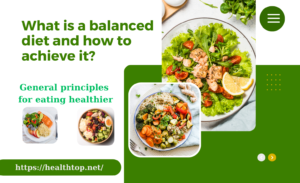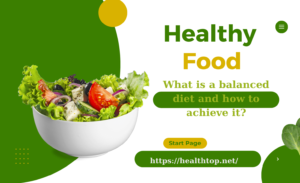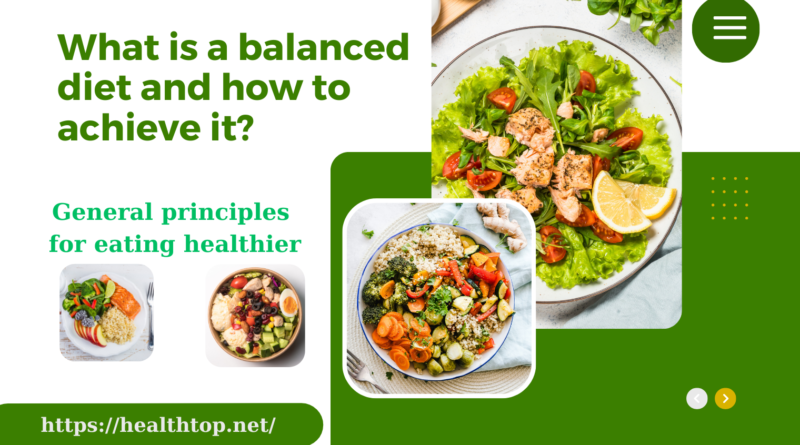What is a balanced diet and how to achieve it?
Contents
What is a balanced diet and how to achieve it?
A balanced diet is a diet that includes different foods in certain quantities and proportions so that the need for calories, proteins, vitamins, minerals and alternative nutrients is sufficient. and a small amount is stored to replenish nutrients in the short term. This article will help you better understand what a balanced diet is and how to achieve healthy eating.

How To Lose Weight at Home
-
What is a balanced diet?
A balanced diet must provide bioactive phytochemicals such as fiber, antioxidants and health-promoting nutrients. A balanced diet should provide approximately 60-70% of total calories from carbohydrates, 10-12% from protein and 20-25% of total calories from fat.
To get the nutrition you need, get most of your daily calories from these sources:
Fresh fruit
Fresh fruits and vegetables
Cereal
Kinds of bean
Nuts
Your body uses energy from food to walk and run, think, breathe, and other important functions. The average person needs about 2000 calories a day to maintain weight, but the number of calories will depend on their age, gender and level of physical activity. Men tend to need more calories than women, and people who exercise need more calories than people who don’t exercise.
-
Health benefits of a balanced diet
Eating healthy increases your energy, improves the way your body functions, strengthens your immune system and prevents weight gain. Other key benefits are:
Meet your nutritional needs. A balanced, varied diet provides the nutrients needed to avoid nutritional deficiencies.
Prevention and treatment of some diseases. Eating healthy can prevent the risk of developing certain diseases such as diabetes, cancer and cardiometabolic disease. It is also useful in treating diabetes and high blood pressure.otein
Following a special diet can reduce symptoms and may help you better control your disease.
Feel energized and control your weight. A healthy diet will help you feel taller, give you more energy, and help you fight stress.
-
What to eat to have a balanced diet
A healthy, balanced diet will typically include the following nutrients:
Vitamins, minerals and antioxidants
Carbohydrates, including starch and fiber
Protein
Healthy fats
People following a vegan diet will focus exclusively on plant-based foods. They will not eat meat, fish or dairy, but their diet will include other items that provide similar nutrients.
For example, tofu and beans are plant-based sources of protein. Some people are dairy intolerant but can still build a balanced diet by choosing a variety of nutrient-rich alternatives.
Let’s learn about foods to eat and avoid to have a balanced diet.
3.1 Fruit
Fruits are so nutritious, they make a snack or dessert to satisfy those with a sweet tooth.
Choose fresh, local and seasonal fruits that provide more nutrients than imported fruits. Fruits are high in sugar, but this sugar is natural sugar. Unlike candy and many sweet desserts, fruit also provides fiber and other nutrients. Fruit does not cause a spike in sugar levels but also increases the supply of vitamins, minerals and antioxidants necessary for the body.
If you have diabetes, your doctor or nutritionist will advise you on which fruits to choose, how much to eat and when to eat them.
3.2. Vegetables
Vegetables are a major source of essential vitamins, minerals and antioxidants. Eat lots of vegetables of different colors to get adequate nutrients.
Dark vegetables are an excellent source of many nutrients, some dark vegetables include:
Spinach
Kale
Broccoli
Reasonably priced local seasonal vegetables that are fresh and easy to prepare are the perfect choice for a balanced diet. You can prepare it in the following ways:
As a side dish
Stir-fry with a little olive oil
Prepare mixed vegetable salad
Prepare smoothies or detox dishes
Add to stews, soups, noodle dishes…
3.3.Nuts
Refined white flour is used in many breads and baked goods, but its nutritional value is limited. The reason is because most of the good stuff is in the seed’s shell, or the outer shell has been removed during processing.
Whole grain products include the entire grain and hull. They provide additional vitamins, minerals and fiber. Many people enjoy eating cereal because it adds flavor and texture to the dish.
3.4. Proteins
Meats and beans are major sources of protein, which are essential for wound healing and maintaining and developing strong muscles.
Animal protein
Include :
Red meat: Beef, pork, lamb
Poultry: Chicken, duck
Fish: Salmon, sardines and other oily fish.
Processed meats and red meat may increase the risk of cancer and other diseases. Some processed meats also contain a lot of preservatives and salt. It is best to choose fresh meat, slaughtered on the same day.
Vegetable protein
Nuts, beans and soy products are good sources of protein, fiber and other nutrients. These are considered healthy alternatives to meat.
Some examples are: Lentils, peas, almonds, sunflower seeds, walnuts, soybeans..
3.5. Dairy products
Dairy products provide essential nutrients, including:
Protein
Calcium
Vitamin D
They contain fat. If you want to limit fat consumption, consult your doctor to choose the right product for you.
For those following a vegan diet, many other milk alternatives are available, made from:
Linseed
Almonds and cashews
Soy bean
Oat
Coconut
They are often fortified with calcium and other nutrients, making them a great alternative to cow’s milk. Some have added sugar, so read the label carefully when choosing.
3.6. Fats and oils
Fat is essential for energy and cell health, but too much fat can add more calories than the body needs and can lead to weight gain.
Previously, many people believed that saturated fat should be limited because it will increase cholesterol levels. However, more recent research suggests that partial replacement with unsaturated fats reduces the risk of cardiovascular disease and that some saturated fat should still remain in the diet – around 10%. or less calories
But you should especially avoid trans fats.
Recommendations for fat supplementation include:
Recommended use: Vegetable oil and fish oil
Limit fat: Butter, cheese
Fats to cut back on: trans fats, used in many processed and pre-made foods, such as donuts, fried chicken, french fries…
Most experts consider olive oil to be a healthy fat, and especially extra virgin olive oil, which is the least processed.
-
General principles for eating healthier
The most important rule of healthy eating is not to skip any meals. Skipping meals lowers your metabolic rate. Normal eating includes 3 main meals and 2 snacks between main meals. Also, never skip breakfast. This is the most important meal of the day.

Learn simple ways to prepare food. Eating healthy doesn’t mean eating complicated meals. Keep meal prep easy, eat more raw foods like salads, fruit, and vegetable juices, and focus on the pleasure of eating healthy food rather than the calories.
It’s important to stop when you feel full. This will help you maintain your weight at a level. This will also help you stay alert and feel your best.
Drink a lot of water. Keep a bottle of water near you while working, watching TV, etc.
You should use a variety of foods on the menu. No food has all the nutrients.
To improve the quality of grains and pulse proteins, the minimum ratio between grain proteins and pulse proteins should be 4:1. In terms of grains, it would be eight parts grain and
What do you know about weight loss pills?
Eat five servings of fruit and vegetables every day.
Keep a supply of healthy snacks on hand. This will prevent you from eating an unhealthy snack when you’re hungry.
Remove all visible fat from the food before you cook it. Peel the chicken skin off the meat and trim off the white fat from the meat.
Limit stimulants such as caffeine, alcohol and refined sugar.
Limit the number of times you eat out to once a week. Bring your own packed lunch to work.
Only eat things you like the taste of – find things that work for you and don’t force yourself to eat things just because they’re good for you.


Enregistré en tant que favori, j’aime vraiment votre blog !